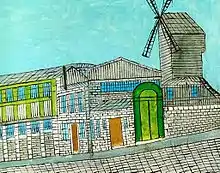Louis Vivin
Louis Vivin (born 28 July 1861, Hadol, France; died 28 May 1936 in Paris) was a French primitivist painter.

Biography
Vivin was born in Hadol, France. He showed great enthusiasm for painting as a child, but his career took him in a completely different direction: until 1922 he worked for the mobile branch of the French postal service – "travel[ing] about the country a good deal, but always in a windowless railway mail car, lighted from above and walled by tiers of pigeonholes"[2] – pursuing his art only in his spare hours.[3] During this time he produced a series of maps showing the location of each post office in every postal district of France; this won him two years' seniority, the rank of inspector and the ribbon of the Palmes académiques, but the postal authorities decided that it would be too expensive to have the maps printed.[4]
In 1889 he moved to Paris, where he lived with his wife in a small fifth-floor flat – two rooms and kitchen – in the district of Montmartre.[5][6][7] He visited the Louvre and the Musée du Luxembourg: "The old masters left him unimpressed, but he liked Corot and Courbet, and fell in love with Meissonier. One night he had a vision: Meisoonier appeared in a dream and told him that he could be a great artist if he tried."[8]
Once he retired, on a pension,[9] in 1923, Vivin finally became a full-time artist.[10]
He was self-taught and a representative of naïve painting. Eventually, he was discovered by the German art critic Wilhelm Uhde (1874–1947), an association which helped him start exhibiting and build a reputation as a serious artist.
Towards the end of his life he had a stroke, followed by another, which affected his speech and left him unable to paint. He died, aged 75, on 28 May 1936, and was buried in the Cimetière parisien de Pantin.[11]
Works
The subjects of Vivin's paintings were still life, hunting subjects, and the city of Paris,[12] and "illustrated books, magazine, loose flower prints, [and] chromolithographed picture postcards" were his models.[13] Vivin was a contemporary of Henri Rousseau, Camille Bombois, André Bauchant, and Séraphine Louis, known collectively as the "Sacred Heart Painters" and as masters of French naïve painting.[14] Vivin's works are known to have a sad and dismal theme to them. He was also known for painting from his memory. Louis Vivin was influenced by the work and details of Jean-Louis-Ernest Meissonier’s paintings. His works depicted genre scenes, flower pieces, hunting scenes and views of Paris, "notable for their charmingly wobbly perspective effects". [15]
Louis Vivin’s first one-man exhibition was placed at the Galerie des Quatre Chemins, and it was organized by Wilhelm Uhde in 1927.[10] His later work was considered to become less dependent of the melancholy mood, and it focused more on blocks of color and form.[5][6]
Lists of his selected artworks
Southampton City Art Gallery[16]
- Venice: Canal Scene with a Church
- La main chaude
- Les Invalides
- Venice: Canal Scene with a Bridge
Auction Christie's[17]
- La place des Halles et l'eglise Saint-eustache, Paris, 1935
- Sacre coeur
- Vue de sacre coeur
Private collections[18]
- Casino de Biarritz
- The Flower Market, 1914
- Gare Montparnasse, Paris
- Luncheon on the Grass, 1925
- Paris, Eglise de la Trinité, 1925
- Paris, Montmartre: Cirque Medrano, 1925
References
- "Le Moulin de la Galette, 1926 (oil on canvas)".
- Wilhelm Uhde, trans. Ralph Thomson, Five Primitive Masters (New York: Quadrangle Press, 1949), p. 53.
- Brodskaia, Natalia. Naive Art. p. 117.
- Uhde, Five Primitive Masters, p. 53.
- "Louis Vivin (1861–1936)". Galerie St. Etienne art. Retrieved 17 July 2013.
- "Louis Vivin (French 1861–1936)". Feoli Fine Art. Retrieved 17 July 2013.
- Uhde, Five Primitive Masters, p. 49.
- Uhde, Five Primitive Masters, p. 53.
- Uhde, Five Primitive Masters, p. 53.
- "Louis Vivin (1861–1936)". ArtFact. Retrieved 17 July 2013.
- Uhde, Five Primitive Masters, pp. 63–4.
- Hamilton, George H. (1993). Painting and Sculpture in Europe: 1880–1940. pp. 226–227. ISBN 0300056494.
- Uhde, Five Primitive Masters, p. 50.
- Kallir, Jane. The Folk Art Tradition: Naïve Painting in Europe and the United States. pp. 42. ISBN 067032325X.
- Louis Vivin Retrieved on 28 Feb 2018.
- Louis Vivin Retrieved on 28 Feb 2018.
- Some works of Louis Vivin Retrieved on 28 Feb 2018.
- Louis Vivin - Artworks Retrieved on 28 Feb 2018.